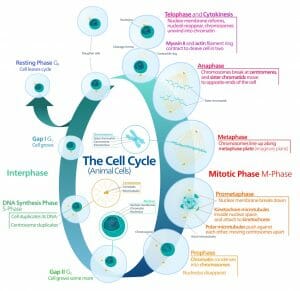When an organism grows, it’s because its cells are dividing not getting bigger. Cells divide for several reasons including to keep them from getting too big. As a cell gets bigger, it has a difficult time keeping up with taking in the extra nutrients it needs and expelling more waste. In other words, as the cell gets bigger, it has less surface area compared to its size—the surface area to volume ratio of the cell decreases as it gets bigger.
Cells grow during the three phases of interphase during which time the chromosomes are duplicated and more proteins and organelles are made. This is what increases the amount of cellular contents while the surface area of the cell membrane stays the same. Cell division solves the problem of increasing size by reducing the volume of cytoplasm in the two daughter cells and dividing up the duplicated DNA and organelles, thereby increasing surface to volume ratio of the cells.

The image above shows the process of animal cell division. Notice the size of the cell starting to get bigger during interphase.
References
- Mitosis. (n.d.) In Wikipedia. Retrieved September 13, 2017 from https://en.wikipedia.org/wiki/Mitosis
